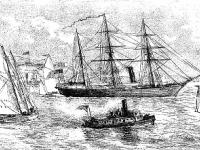Before embarking on the HCI-PSAR project, I had no idea how many signficant world explorers called the Philadelphia area home. On a recent visit to the Sharon Hill Historical Society (Delaware County, Pa.), I learned about Arctic explorer George W. Melville (1841-1912). He joins the ranks of William Edgar Geil, the Doylestown native who walked the entire length of the Great Wall of China and visited parts of Africa and Oceania around the turn of the 19th century. Melville was also a naval engineer, like John Ericsson, whose papers we surveyed at the American Swedish Historical Museum.
Born in New York City in 1841, Melville joined the United States Navy in 1861 and served on several vessels during the Civil War. In 1873, Melville first ventured into the Arctic when he volunteered as engineer on the Tigress on its mission to recover the lost ship Polaris. That same year, he purchased a home at 326 Sharon Avenue in Sharon Hill, Pennsylvania from the Sharon Land Association.
Not long after, in 1879, Melville embarked on the voyage for which he would become well-known: the famous Jeannette voyage with George W. DeLong. Seeking an ocean passage to the Atlantic by way of Siberia, the Jeannette crashed and was destroyed. Melville commanded the only boatload of men who survived, eventually reaching safety on the Lena River in the far north of Siberia. He then led a brave but fruitless expedition of over one thousand miles in search of DeLong and other survivors. He found them dead, but managed to recover all the records of the expedition. Melville reported about the hardships of his journey in a book published in 1884, In the Lena Delta. He was awarded the Congressional Gold Medal for his bravery and was promoted to the rank of Chief Engineer. Melville left a wooden cross in Siberia for his fallen comrades, a stone copy of which was later erected in the U.S. Naval Academy cemetery as a memorial to the Jeannette and its brave crew.
Melville travelled once more to the Arctic, serving as chief engineer of Thetis on a relief mission to find the Greely expedition (part of an international scientific study of the far north) in 1884, before settling into desk work. He was appointed Chief of the Bureau of Steam Engineering in 1887 and promoted to Engineer in Chief of the Navy in 1900. In this role, he reformed and professionalized the U.S. Naval Engineering department, and established the Engineering Experiment Station (EES) in Annapolis. He was a founder of the Fuel Oil Testing Plant (which eventually grew into the Naval Ship Systems Engineering Station, NAVSSES), the Naval Surface Warfare Center Carderock Division (NSWCCD) laboratory, and the Naval Postgraduate School.
Melville retired in 1903 and spent his final years in his Sharon Hill home. The U.S. Navy named two ships and one award after Melville. A statue of him stands in the Philadelphia Navy Yard.
To learn more about George W. Melville and the town he called home, be sure to "explore" the collections of the Sharon Hill Historical Society!
See all finding aids for Sharon Hill Historical Society
Bibliography
"George W. Melville." Naval Surface Warfare Center Carderock Divison. Accessed December 26, 2013. http://www.navsea.navy.mil/nswc/carderock/pub/who/heritage/melville.aspx
Melville, George W. In the Lena Delta. Boston: Houghton, Mifflin and Company, 1885. Accessed December 26, 2013. https://archive.org/details/inthelenadelta002487mbp

